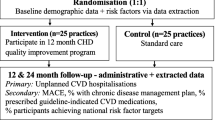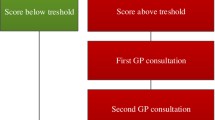Abstract
Background: A primary care practice in the West of Scotland used clinical governance funding to develop a heart disease prevention clinic to target patients with existing heart disease. The practice nurse enlisted the help of the practice pharmacist and the protocol for the clinic was subsequently developed with the involvement of both practitioners. Objective: The aim of this project was to identify and offer health screening and appropriate disease modifying treatment to patients of a primary care (or general medical) practice suffering from cardiovascular heart disease in a clinic run jointly by a practice nurse and pharmacist.Method: Patients identified by the practice pharmacist were offered a full health screen. Their clinical parameters were assessed and appropriate disease modifying drug therapy and lifestyle advice was offered in a review clinic with the practice nurse and pharmacist. Results: the practice pharmacist identified over 212 patients over a 30‐month period. A majority demonstrated hypertension (91%) and angina (89%), while over half (57%) had suffered a heart attack. Statin therapy was modified in a large number of patients (47%) and the number of patients with satisfactory total cholesterol levels has increased from 30% to 57% (p < 0.001). Aspirin and beta‐blocker therapy has been initiated in a significant number of patients (53% and 26% respectively). Twelve patients (6%) stopped smoking; however, many 42% continued to smoke. The general medical doctors (GPs) who demonstrated a change in their own practice readily accepted changes to therapy recommended by the practice nurse and pharmacist. The practice pharmacist offset the additional cost of drug spend on statin therapy by making savings in other therapeutic areas. Conclusion: A secondary heart disease clinic can benefit patients by optimising drug and lifestyle therapy. While the inclusion of a pharmacist confers clinical and economic benefits.
Similar content being viewed by others
References
Scottish Office Department of Health. Health in Scotland 2000. Edinburgh: The Stationery Office, 2000.
Scottish Office Department of Health. Scotland's Health: Scottish Health Survey 1998. Edinburgh: The Stationery Office, 2000.
Scottish Intercollegiate Guidelines Network (SIGN). Management of Diabetic Cardiovascular Disease. Edinburgh: SIGN, 1997 (SIGN publication no.19).
Scottish Intercollegiate Guidelines Network (SIGN). Drug Therapy for Peripheral Vascular Disease. Edinburgh: SIGN,1998 (SIGN publication no. 27).
Scottish Intercollegiate Guidelines Network (SIGN). Antithrombotic Therapy. Edinburgh: SIGN, 1999 (SIGN publication no. 36).
Scottish Intercollegiate Guidelines Network (SIGN). Lipids and the Primary Prevention of Coronary Heart Disease. Edinburgh: SIGN, 1999 (SIGN publication no. 40).
Scottish Intercollegiate Guidelines Network (SIGN). Management of Stable Angina. Edinburgh: SIGN, 2001 (SIGN publication no. 51).
Scottish Intercollegiate Guidelines Network (SIGN). Secondary Prevention of Coronary Heart Disease. Edinburgh: SIGN, 2000. (SIGN publication no. 41).
Wood D, Durrington P, Poulter N, McInnes G, Rees A, Wray R on behalf of the British Cardiac Society, British Hyperlipidaemia Association, British Hypertension Society, and British Diabetic Association. Joint British recommendations on prevention of coronary heart disease in clinical practice. Heart 1999; 80 (Suppl 2): S1–S29.
Lanarkshire Prescribing Advisers Guidelines. Lanarkshire Prescribing Advisers. Lanarkshire, UK: Lanarkshire Primary Care Trust, 1999.
Greater Glasgow Health Gain Commissioning Team. Greater Glasgow Health Board (GGHB) Guidelines for Cholesterol Management. Glasgow, 1999.
World Health Organisation (Europe) and International Diabetes Federation (Europe). Diabetes Care and Research in Europe; the St Vincent Declaration. Diabetes Med 1990; 7: 360–70.
Collaborative overview of randomised trials of anti-platelet therapy-I: Prevention of death, myocardial infarction and stroke by prolonged antiplatelet therapy in various categories of patients. Antiplatelet Trialists' Collaboration. BMJ 1994; 308: 81–106.
Eccles M, Freemantle N, Mason J. North of England evidence based Guideline development project: guideline on the use of aspirin as secondary prophylaxis for vascular disease in primary care. North of England Aspirin Guideline Development Group. BMJ 1998; 316: 1303–9.
The Beta Blocker Pooling Project (BBPP): subgroup findings from randomised trials in post infarction patients. The Beta Blocker Pooling Project Research Group. Eur Heart J 1988; 9: 8–16.
Ebrahim S, Smith GD. Systematic review of randomised controlled trials of multiple risk factor interventions for preventing coronary heart disease. BMJ 1997; 314 1666–74
Wilhelmsson C. Coronary heart disease; epidemiology of smoking and intervention studies of smoking. Am Heart J 1988; 115: 242–9
ASH Scotland/Health Education Board for Scotland. Breaking down the barriers. Women low income and smoking. Final Report. Edinburgh, 1999.
Department of Health. Smoking Kills: A White Paper on Tobacco. London: The Stationery Office, 1998.
Bradley TJ, Round AP, Ramsden M. The success of an evidence based raional prescribing intervention: A retrospective study. Pharm J 2000; 265 (Jul 1) 25–29.
Author information
Authors and Affiliations
Rights and permissions
About this article
Cite this article
Reilly, V., Cavanagh, M. The clinical and economic impact of a secondary heart disease prevention clinic jointly implemented by a practice nurse and pharmacist. Pharm World Sci 25, 294–298 (2003). https://doi.org/10.1023/B:PHAR.0000006526.55922.8d
Issue Date:
DOI: https://doi.org/10.1023/B:PHAR.0000006526.55922.8d




